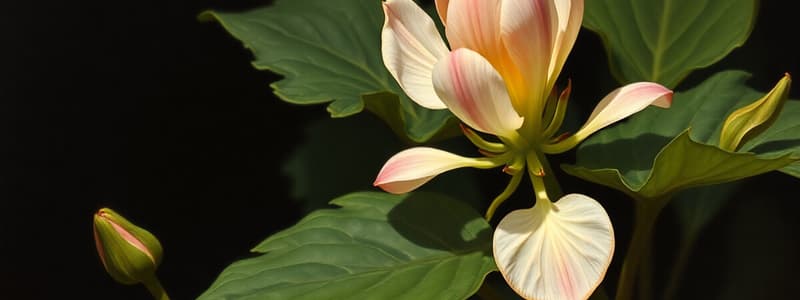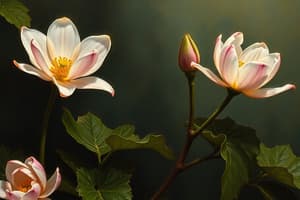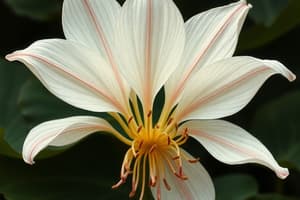Podcast
Questions and Answers
What advantage does asexual reproduction have over sexual reproduction in stable environments?
What advantage does asexual reproduction have over sexual reproduction in stable environments?
- It relies on external fertilization.
- It requires a higher investment of energy.
- It produces genetically diverse offspring.
- It allows individuals to reproduce with lower investment of energy. (correct)
What is the role of rhizomes in vegetative reproduction?
What is the role of rhizomes in vegetative reproduction?
- They store nutrients for the plant during winter.
- They create a network underground, giving rise to new shoots. (correct)
- They develop into flowers to attract pollinators.
- They are slender stems growing above the soil.
In angiosperms, what does the diploid sporophyte generation give rise to?
In angiosperms, what does the diploid sporophyte generation give rise to?
- Fruits and seeds.
- Another sporophyte generation.
- A haploid gametophyte generation. (correct)
- Pollen grains.
Which structure develops from microspores in the angiosperm life cycle?
Which structure develops from microspores in the angiosperm life cycle?
What comprises the male reproductive structures of flowers?
What comprises the male reproductive structures of flowers?
How do adventitious plantlets form in some angiosperms?
How do adventitious plantlets form in some angiosperms?
What distinguishes sexual reproduction in angiosperms from asexual reproduction?
What distinguishes sexual reproduction in angiosperms from asexual reproduction?
What is the function of the carpel in flowering plants?
What is the function of the carpel in flowering plants?
What is the primary function of the stigma in the carpel?
What is the primary function of the stigma in the carpel?
Which statement correctly describes a monoecious plant?
Which statement correctly describes a monoecious plant?
What is the result of meiosis in the microspore mother cells?
What is the result of meiosis in the microspore mother cells?
What occurs immediately after the generative cell divides in the pollen grain?
What occurs immediately after the generative cell divides in the pollen grain?
In the ovary, what happens to the diploid megaspore mother cell during reproduction?
In the ovary, what happens to the diploid megaspore mother cell during reproduction?
How can self-pollination potentially impact genetic diversity?
How can self-pollination potentially impact genetic diversity?
What role do pollinators play in the life cycle of angiosperms?
What role do pollinators play in the life cycle of angiosperms?
What is one reason that flower color and form have evolved?
What is one reason that flower color and form have evolved?
What triggers the dormancy process in temperate zone plants?
What triggers the dormancy process in temperate zone plants?
Which type of tropism involves the growth of plant stems upwards?
Which type of tropism involves the growth of plant stems upwards?
In the study conducted by Irwin and Strauss, how was the second population of wild radishes obtained?
In the study conducted by Irwin and Strauss, how was the second population of wild radishes obtained?
What is the definition of thigmotropism in plants?
What is the definition of thigmotropism in plants?
What response is indicated by phototropism in plants?
What response is indicated by phototropism in plants?
What is the primary purpose of seed dormancy?
What is the primary purpose of seed dormancy?
Which method of seed dispersal is associated with fleshy fruits?
Which method of seed dispersal is associated with fleshy fruits?
What initiates the germination process of a seed?
What initiates the germination process of a seed?
In monocots, which structure emerges first during the germination process?
In monocots, which structure emerges first during the germination process?
What role do hormones play in plant development?
What role do hormones play in plant development?
Which statement about differentiation in plants is true?
Which statement about differentiation in plants is true?
What triggers the process of fertilization in angiosperms?
What triggers the process of fertilization in angiosperms?
What signals the plant to begin growth after germination?
What signals the plant to begin growth after germination?
Which statement accurately describes the process of double fertilization in angiosperms?
Which statement accurately describes the process of double fertilization in angiosperms?
Which type of fruit is likely to be dispersed by wind?
Which type of fruit is likely to be dispersed by wind?
What is a key characteristic of wind-pollinated flowers compared to insect-pollinated flowers?
What is a key characteristic of wind-pollinated flowers compared to insect-pollinated flowers?
What happens to the embryo during the early stages of its development?
What happens to the embryo during the early stages of its development?
What role does the seed coat play in the development of seeds?
What role does the seed coat play in the development of seeds?
Which of the following is required for the germination of a seed?
Which of the following is required for the germination of a seed?
For effective pollination by animals, what is essential?
For effective pollination by animals, what is essential?
What initiates the growth of the pollen tube after pollen grains adhere to the stigma?
What initiates the growth of the pollen tube after pollen grains adhere to the stigma?
What is auxin primarily responsible for in plants?
What is auxin primarily responsible for in plants?
Which plant hormone is identified as effective in controlling weeds?
Which plant hormone is identified as effective in controlling weeds?
What type of flowering response do long-day plants exhibit?
What type of flowering response do long-day plants exhibit?
F.C. Steward's experiments demonstrated the ability to regenerate plants from which type of tissue?
F.C. Steward's experiments demonstrated the ability to regenerate plants from which type of tissue?
Which of the following statements about hormones in plants is correct?
Which of the following statements about hormones in plants is correct?
Which hormone is primarily associated with inhibiting growth and promoting dormancy?
Which hormone is primarily associated with inhibiting growth and promoting dormancy?
In the context of phototropism, what causes the bending of a plant towards light?
In the context of phototropism, what causes the bending of a plant towards light?
Which type of plants flower with no regard to the length of day or night?
Which type of plants flower with no regard to the length of day or night?
Flashcards
Vegetative Reproduction
Vegetative Reproduction
A type of reproduction in plants where new organisms are created from parts of a parent plant, such as stems, roots, or leaves.
Runners
Runners
Slender stems that grow along the soil surface, allowing plants like strawberries to spread horizontally.
Rhizomes
Rhizomes
Underground horizontal stems that produce new shoots, creating a network of plants like irises and potatoes.
Suckers
Suckers
Signup and view all the flashcards
Adventitious Plantlets
Adventitious Plantlets
Signup and view all the flashcards
Stamen
Stamen
Signup and view all the flashcards
Anther
Anther
Signup and view all the flashcards
Carpel
Carpel
Signup and view all the flashcards
What is the carpel?
What is the carpel?
Signup and view all the flashcards
What is the ovary?
What is the ovary?
Signup and view all the flashcards
What is the style?
What is the style?
Signup and view all the flashcards
What is the stigma?
What is the stigma?
Signup and view all the flashcards
What is an imperfect flower?
What is an imperfect flower?
Signup and view all the flashcards
What is a monoecious plant?
What is a monoecious plant?
Signup and view all the flashcards
What is pollination?
What is pollination?
Signup and view all the flashcards
What is self-pollination?
What is self-pollination?
Signup and view all the flashcards
Animal Pollination Specificity
Animal Pollination Specificity
Signup and view all the flashcards
Pollen Tube Growth
Pollen Tube Growth
Signup and view all the flashcards
Double Fertilization
Double Fertilization
Signup and view all the flashcards
Embryo Dormancy
Embryo Dormancy
Signup and view all the flashcards
Seed Coat
Seed Coat
Signup and view all the flashcards
Germination
Germination
Signup and view all the flashcards
Endosperm
Endosperm
Signup and view all the flashcards
Wind-Pollinated Angiosperms
Wind-Pollinated Angiosperms
Signup and view all the flashcards
What is Germination?
What is Germination?
Signup and view all the flashcards
What is a seed coat?
What is a seed coat?
Signup and view all the flashcards
What is seed coat rupture?
What is seed coat rupture?
Signup and view all the flashcards
What are meristematic tissues?
What are meristematic tissues?
Signup and view all the flashcards
What is Differentiation?
What is Differentiation?
Signup and view all the flashcards
What are Plant Hormones?
What are Plant Hormones?
Signup and view all the flashcards
What is Reversible Differentiation in Plants?
What is Reversible Differentiation in Plants?
Signup and view all the flashcards
What is Expression of Genetic Information?
What is Expression of Genetic Information?
Signup and view all the flashcards
Dormancy
Dormancy
Signup and view all the flashcards
Tropisms
Tropisms
Signup and view all the flashcards
Phototropism
Phototropism
Signup and view all the flashcards
Gravitropism
Gravitropism
Signup and view all the flashcards
Thigmotropism
Thigmotropism
Signup and view all the flashcards
Plant hormone production
Plant hormone production
Signup and view all the flashcards
Auxin
Auxin
Signup and view all the flashcards
Darwin's Phototropism Experiment
Darwin's Phototropism Experiment
Signup and view all the flashcards
Went's Auxin Experiment
Went's Auxin Experiment
Signup and view all the flashcards
Synthetic Auxins and Weed Control
Synthetic Auxins and Weed Control
Signup and view all the flashcards
Photoperiodism
Photoperiodism
Signup and view all the flashcards
Long-day Plants
Long-day Plants
Signup and view all the flashcards
Study Notes
Angiosperm Reproduction
- Angiosperms can reproduce asexually or sexually.
- Asexual reproduction is advantageous in stable environments as it involves cloning parts of a parent plant.
- Vegetative reproduction creates new individuals by cloning parts of the parent.
- Asexual reproduction requires less energy than sexual reproduction.
Forms of Vegetative Reproduction
- Runners: Slender stems growing along the soil surface (e.g., strawberries).
- Rhizomes: Underground horizontal stems creating a network and giving rise to new shoots (e.g., irises, potatoes).
- Suckers (or sprouts): Produced by roots, leading to new plants (e.g., cherry, apple, raspberry).
- Adventitious plantlets: Arise from meristematic tissue in leaf notches (e.g., Kalanchoë daigremontiana).
Sexual Reproduction in Angiosperms
- Involves an alternation of generations.
- The diploid sporophyte generation produces a haploid gametophyte generation.
- Male gametophytes are pollen grains developing from microspores.
- Female gametophytes are embryo sacs developing from megaspores.
- These gametophytes are found in specialized structures of the flower.
- Reproductive organs are produced seasonally.
Flower Structure
- Most flowers contain male and female parts.
- Stamens: Male parts, with anthers at the tips.
- Carpels: Female parts, consisting of an ovary (lower bulging part), style (slender stalk), and stigma (sticky tip).
- Some flowers contain only male OR female parts and are called imperfect flowers.
- Plants with both male and female imperfect flowers on the same plant are called monoecious.
Pollen Formation
- Pollen sacs inside anthers contain microspore mother cells.
- Microspore mother cells undergo meiosis creating four haploid microspores.
- Microspores then undergo mitosis to produce pollen grains, which include generative cells and a tube cell nucleus.
- The tube cell nucleus develops into the pollen tube.
- The generative cell divides into two sperm cells.
Egg Formation
- Ovules within the ovary contain diploid megaspore mother cells.
- Meiosis in megaspore mother cells produces four haploid megaspores.
- One megaspore undergoes multiple mitotic divisions creating eight haploid nuclei.
- These nuclei are arranged within an embryo sac.
Pollination
- Pollen transfer from the anther to the stigma.
- Self-pollination occurs when pollen from a flower's anther pollinates the same flower's stigma, leading to self-fertilization.
Animal Pollination
- Many angiosperms use animals (pollinators) to carry pollen from one flower to another.
- Food (e.g., nectar) rewards the pollinators.
- Flower color and form are shaped by evolution to attract specific pollinators.
- For effective animal pollination, the insect or animal must visit plants of the same species.
Wind Pollination
- In some angiosperms and all gymnosperms, pollen is dispersed by wind and passively reaches the stigmas.
- Plants must grow relatively close together in areas with ample wind.
- Wind-pollinated angiosperm flowers are typically small, green, and odorless.
Fertilization
- Pollen grains adhere to the stigma and grow a pollen tube.
- The pollen tube travels down the style reaching the ovule.
- Two sperm cells are released from the pollen tube.
- One sperm fertilizes the egg, while the other fuses with the polar nuclei to form endosperm.
- This process is called double fertilization.
Seed Development
- After fertilization, cell division forms the embryo.
- Embryo develops and enters a dormant stage due to drying.
- Embryo development usually pauses shortly after the apical meristems and seed leaves, called cotyledons, have developed.
Seed Coat and Germination
- The outer covering of the ovule forms the seed coat.
- Seed coat is impermeable and encloses the dormant embryo and food source.
- Germination, the resumption of metabolic activity leading to growth, only occurs when water and oxygen reach the embryo.
- Germination ensures seed growth when conditions are favorable for plant survival.
Fruit Formation and Dispersion
- The flower ovary develops into fruit during seed formation.
- Fruits contain seeds and form in multiple ways with varied forms.
- Fleshy fruits are generally dispersed by birds and other vertebrates.
- Some fruits disperse through the wind, attaching to mammals or bird feathers.
- Some fruits disperse via water.
Germination
- A seed absorbs water when conditions are suitable for germination.
- Aerobic respiration starts after the seed coat ruptures.
- Roots emerge first, followed by shoot growth in eudicots (cotyledons emerge with the stem) and monocots (coleoptile emerges).
Plant Hormones
- Pattern of growth and differentiation in the embryo is repeated indefinitely after germination.
- Entire plants can be regenerated from differentiated plant tissues.
- A plant's development depends on meristematic tissue activity with interactions mediated through plant hormones.
- Differentiation in plants is largely reversible.
- Scientists have shown differentiated plant cells can express hidden genetic information given right environmental signals.
- Plant hormones control the expression of some plant genes.
- All plant hormones are produced in various tissues that have multiple functions.
- F.C. Steward successfully regenerated plants from isolated phloem tissue.
Auxin
- Phototropism: Plant growth toward light.
- Charles and Francis Darwin's experiments suggested a light-sensitive substance in plants that caused bending.
- This substance was later identified as auxin.
- Frits Went researched how auxin governs plant growth.
- Auxin promotes growth on the side of the seedling exposed to it.
- Auxin causes the shaded side to elongate more, resulting in plant bending toward light.
- Synthetic auxins are used in weed control by causing plant death and reducing ATP production.
- 2,4-D kills broadleaf eudicots with this mechanism.
Photoperiodism and Dormancy
- Photoperiodism: Organisms measure seasonal changes in day and night length.
- Plants' flowering responses are categorized in three areas related to day length:
- Long-day plants: Flower when days become longer (summer).
- Short-day plants: Flower when days become shorter (fall).
- Day-neutral plants: Flower regardless of day length.
- Dormancy: Plants stop growing under unfavorable conditions.
- Dormancy in temperate zones is linked to winter where low temperatures and water freezing limit plant growth.
Tropisms
- Tropisms: Directional and irreversible growth responses to external stimuli.
- Types of tropisms include:
- Phototropism: Growth toward light.
- Gravitropism: Growth related to gravity (stems upward; roots downward).
- Thigmotropism: Response to touch.
Inquiry and Analysis
- Irwin and Strauss: Studied wild radish flower color, its response to selection by pollinators.
- Compared the frequencies of different flower colors in two populations of wild radishes.
- One group's flower colors reflected bee preference for color.
- Another group was created by hand pollinating with no selection, based on color.
Studying That Suits You
Use AI to generate personalized quizzes and flashcards to suit your learning preferences.




